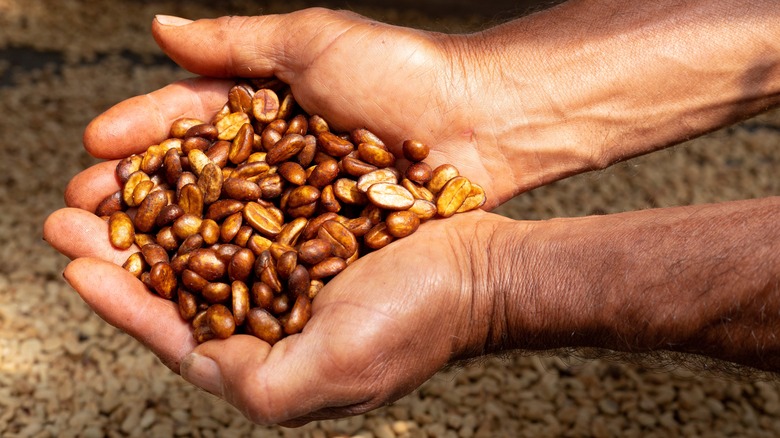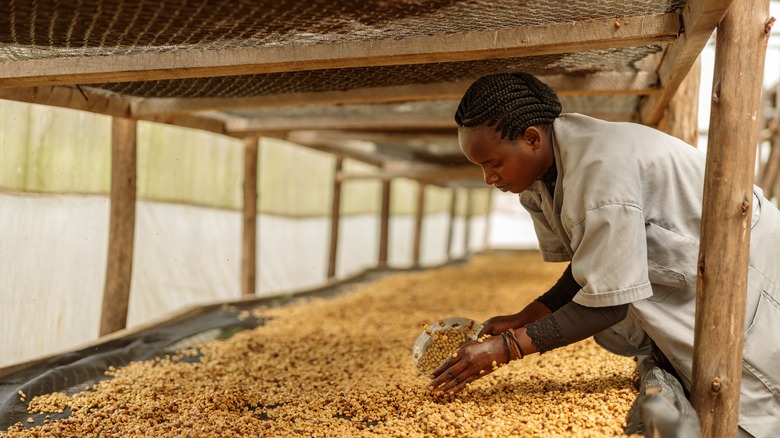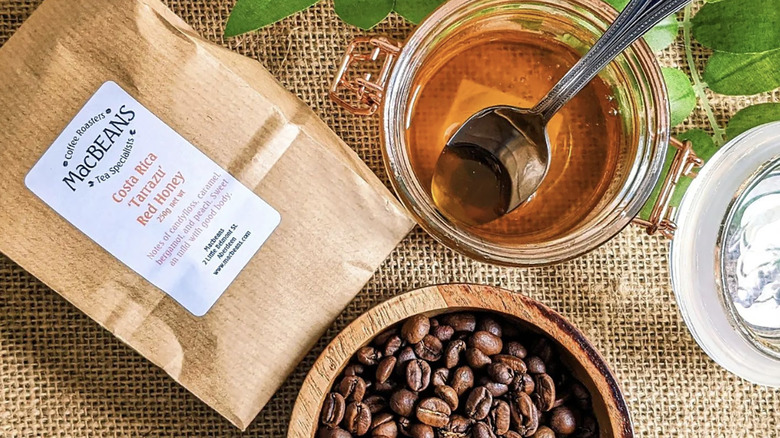Honey Process Coffee Has Nothing To Do With Bees
Making coffee is a true labor of love, even before it gets into your morning mug. The hands-on journey from beans to cup all starts with turning fresh-picked coffee cherries into aromatic roasted beans, a process that requires a lot of hard work and involves a global web of coffee farmers, pickers, processors, agriculturists, and roasters.
There are three primary methods of coffee bean production — all of them resulting in beans that are de-pulped from the cherry, dried, and ready for roasting — though each producing different flavors and mouthfeels. These methods include a dry process (also referred to as natural); a wet (or washed) process; and a highly touted honey/pulped natural process. The latter is a hybrid method that leaves behind a bit of flesh in the de-pulping step, which produces a high-quality bean prized by coffee enthusiasts.
It's a bit of a misnomer as honey-processed coffee actually has nothing to do with bees, hives, or the liquid gold nectar produced by the busy buzzing creatures. It's actually called honey processing because of the viscous stickiness from the pulp as it dries in the sun, which can be likened to the sticky texture of honey. This process can also result in a golden hue for the roasted beans and a slightly sweeter taste in the final brewed coffee drink — all attributes that add to the honey moniker and make the coffee so tasty.
The flavor of honey-processed coffee and how it's made
Though honey-processed coffee in fact contains zero honey, there is still a bit of a natural sweetness to it, which some have said makes it the pinnacle of coffee perfection. It's not an artificial manmade sweetness, either, but rather what's being tasted are the natural sugars within the coffee beans that are allowed to gently blossom through this nuanced production method.
It requires several extra steps, but the work really pays off for a full-bodied coffee that's also comparatively low in acid. Because of this quality, these kinds of beans typically land in the realm of specialty coffee purveyors, like small batch producers, DIYers on Etsy, and in specific honey-processed offerings from the Starbucks Reserve collection.
Traditionally, what's harvested during any kind of coffee bean production is a coffee cherry. Its structure includes an outer skin and several interior layers that cover the ultimate treasure: the interior coffee seed, which we know also know as the coffee bean. Beneath the outer skin is another layer, consisting of pulp or mucilage, and then pectin underneath — this is where those natural sugars reside.
In the honey process method, all of the mucilage isn't stripped from the beans (as done in the wet and dry processing methods). So, the lingering sticky bits penetrate the coffee cherries, creating unique flavor notes that some describe as jammy, sugary, caramely, or similar to a sugar cane sweetness. Depending on the type of coffee bean and where it's grown, the flavors can vary widely.
How colors affect the flavor of honey-processed coffee
The coffee farmers willing to put in the time and effort to make honey-processed beans often reside in known coffee-growing regions such as Brazil, Costa Rica, and a handful of other Central and Latin American countries. These farmers are very hands-on, consistently tossing the beans to keep the sticky mucilage from creating a clumpy mess as the beans dry out on dedicated beds.
If that isn't intriguing enough, there's another layer to honey-processed coffee. Depending on how much sticky stuff remains on the beans, they emerge cloaked in different colors and carry varying levels of sweetness. In general, the more mucilage there is, the sweeter and full-bodied the dried beans will be — which carries over into the coffee you eventually sip and savor.
Here's how particularly colored beans land on the taste and sweetness spectrum: Black means no mucilage has been removed, creating sweet, fruity, full-bodied flavor. Red has roughly 25% mucilage removed for the next level of sweetness; yellow retains 50%, leading to lighter floral notes, sometimes with hints of vanilla; and golden hues indicate 75% of the mucilage has been stripped away for crisp, citrus-like flavors.
Some note another type of bean in the honey process that has 100% removal of the sticky substance, creating a "white honey" coffee bean, but the more traditional categories focus on the black, red, and yellow varieties. Regardless of color and drying times, coffee that hails from the honey-processed natural method nearly always hold a high regard with global connoisseurs.



